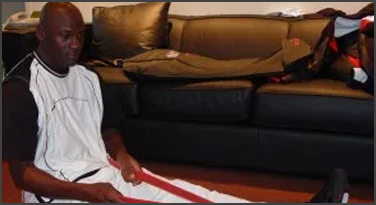I write about this every year, because a) it’s important, b) no one really pays attention to this topic until they’re sitting out of the game with this preventable injury, and c) without a doubt, during every season in every sport, countless athletes will suffer lower leg injuries—calves, ankles, Achilles tendons, I’m not even including knees and feet here—that will cost big players some big time.
Let’s be honest, very few people go into the gym determined to develop really great ankles. Shoulders, back, chest, legs…the glamour muscles get all the work. Ankles are buried in shoes and socks, they don’t show. No one watches the game thinking, “Man, I gotta get some ankles like that.”
When do you notice an ankle?
When it’s injured.
Fact: Lower leg injuries are often preventable with the right training, predictable with the wrong training. I can’t accept a basic athletic injury written off as “one of those things.” One of what things? Something caused that injury, and it’s up to each individual athlete to do everything possible to make sure it doesn’t happen again.
No matter what kind of technology they build into your shoes, no matter what brand or style, they can’t save you if you haven’t taken steps to prevent injury. Neither will braces or tape or any other ‘quick fix’ method of therapy. What can save you from serious injury? Preventative training, preparation, and work.
I originally designed the ATTACK PPT Band & Training Program for MJ, as a regular part of his workouts. 20 minutes twice a week can save your legs and your season.
If you’re an athlete in any sport and your program doesn’t include exercises for your ankles and Achilles tendons, it’s not a complete program. It doesn’t matter how strong you are, how high you jump, how fast you run…if you’re injured, you’re not available to play. And the #1 responsibility of any athlete is to be available to play. There’s no Combine score for ankles or Achilles, but when they’re injured, you get an automatic 2-4….meaning the number of games a sprain could cost you, if you’re lucky. You could miss more.
The stronger your lower legs, the more explosive you’ll be in all directions. Laterally, forward, backward, vertical, stop and go. Think of yourself as a race car: Your hips, glutes, and thighs are your horsepower, your ankles are the tires. In the middle of a race the pit crew doesn’t change the engine, they change the tires so the car can keep performing. Weak tires, weak race.
ARE YOU AT RISK?
The most common injury for any athlete is an ankle injury. Here’s why:
• Too many athletes and trainers believe skill work equals physical conditioning. Completely false. You can have the best skills in the game, but still have physical weakness that only reveals itself when it’s too late…you’re already injured. Talent isn’t enough.
• If you’ve ever been injured, your rehab should never end; once the chain is damaged, it’s damaged. How many times do you see an athlete injure the same area over and over and over, even on the other side? It’s no coincidence. It’s like putting together a car after an accident; the body looks good, but if you really look under the hood you know something happened. So your rehab must continue, becoming part of your lifelong commitment to staying healthy. Without it, your risk of another injury skyrockets.
• If you were taught to work your ankles and Achilles by doing a few one-legged balance movements, you need a new program. These exercises usually work every part of the body except the ankles and Achilles, because of all the other muscle engagement necessary to hold your balance. Unless you know the science of creating an effective tripod with your foot, you’re getting an ineffective workout. Standing on one foot usually causes you to shift your weight to one side of that foot, so only half your muscles are engaged. An effective exercises forces you to use all the muscles without cheating to one side. The slightest deviation in form can make all the difference.
• Ankle and Achilles injuries don’t happen when your foot is in one stable position, they occur when the foot is bent at an irregular angle. If your foot is never worked against resistance in that position, it won’t be strong enough to prevent injury when it’s forced to move that way. Difficult to do without the right program and equipment. You have to challenge the muscles and joints in a way that simulates the movements that can cause injury.
• Ankle braces are supposed to prevent sprains, but they can actually do just the opposite. What happens when you brace something? You’re giving added support from an outside source. Well, when the body gets something from an outside source, it stops doing what it’s supposed to do naturally. So instead of the ankle protecting itself, it relies on the brace, gradually becomes weaker, and ultimately weakens the entire chain up the body. End result: Increased risk of other lower body injuries. Think of it this way: If a doctor gives you crutches or a cane for an injury, you don’t use them forever, right? You use them until you don’t need them, and then you do it on your own. Same philosophy for the ankle brace. Use it while you’re healing, then get rid of it.
HOW A RUBBER BAND CAN SAVE YOUR SEASON
Your lower leg is a complex system of muscles, tendons, and ligaments; it’s extremely difficult to target each one effectively without the right program and exercises. For my athletes, I incorporate the ATTACK PPT Band & Training System into their workouts at least twice a week, using exercises designed specifically to reach those smaller hard-to-train muscles and keep the ankles strong and flexible. The PPT Band targets the Achilles and muscles surrounding the ankle that are most effectively trained when you can create resistance while lengthening the muscle (eccentric resistance) and vary the tempo of the contraction. I’ve seen athletes work on Bosu balls, train in sand, use a balance board–anything that creates an unstable environment and forces all the lower leg muscles to engage—but I’ve never found anything as effective as the ATTACK PPT Band & Training System.
I frequently use the PPT Band as part of the warm-up so it doesn’t add more time to the overall workout; if you usually do a 20 minute warm-up (which is really too long) I’d rather see you spend half of that time on your ankles. Extremely effective in preventing injury, and shortening recovery time in case of injury.
Believe me, I know it’s a lot easier to work on big muscles that show obvious results…much harder to focus on little muscles that hide in your socks. But here’s the bottom line: Athletes who concentrate on those small details get the biggest results. Do the work now in your training, so you don’t have to do it later in physical therapy. Prehab before you rehab.
For more on the ATTACK PPT BAND & Training System Workout, click here.




